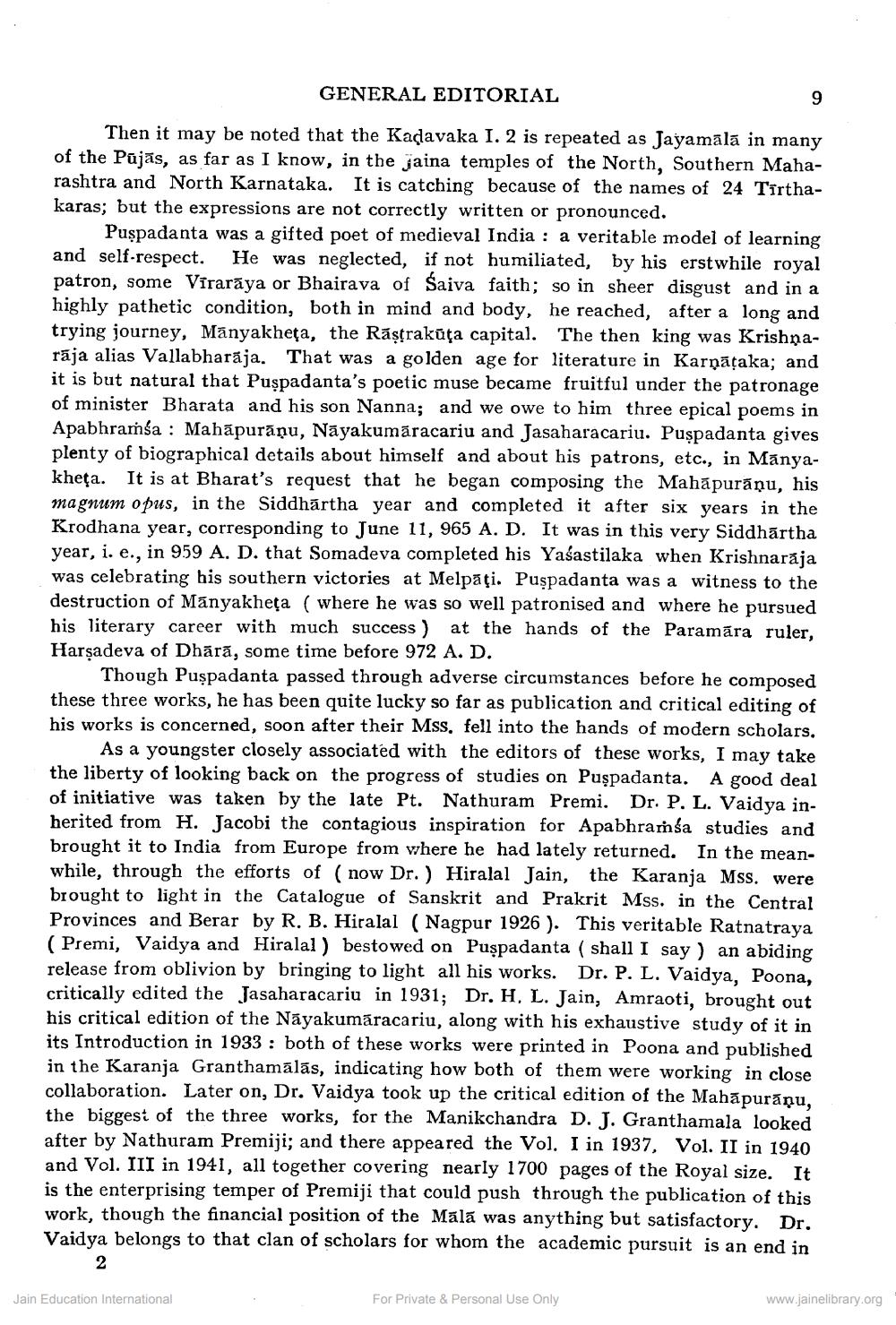________________
GENERAL EDITORIAL
Then it may be noted that the Kadavaka I. 2 is repeated as Jayamala in many of the Pūjas, as far as I know, in the jaina temples of the North, Southern Maharashtra and North Karnataka. It is catching because of the names of 24 Tirthakaras; but the expressions are not correctly written or pronounced.
Puspadanta was a gifted poet of medieval India: a veritable model of learning and self-respect. He was neglected, if not humiliated, by his erstwhile royal patron, some Viraraya or Bhairava of Saiva faith; so in sheer disgust and in a highly pathetic condition, both in mind and body, he reached, after a long and trying journey, Manyakheța, the Raṣṭrakūta capital. The then king was Krishnaraja alias Vallabharaja. That was a golden age for literature in Karnataka; and it is but natural that Puspadanta's poetic muse became fruitful under the patronage of minister Bharata and his son Nanna; and we owe to him three epical poems in Apabhramśa Mahapurāņu, Nayakumaracariu and Jasahara cariu. Puspadanta gives plenty of biographical details about himself and about his patrons, etc., in Manyakheţa. It is at Bharat's request that he began composing the Mahapurāņu, his magnum opus, in the Siddhartha year and completed it after six years in the Krodhana year, corresponding to June 11, 965 A. D. It was in this very Siddhartha year, i. e., in 959 A. D. that Somadeva completed his Yaśastilaka when Krishnaraja was celebrating his southern victories at Melpaţi. Puspadanta was a witness to the destruction of Manyakheța (where he was so well patronised and where he pursued his literary career with much success) at the hands of the Paramāra ruler, Harṣadeva of Dhārā, some time before 972 A. D.
Though Puspadanta passed through adverse circumstances before he composed these three works, he has been quite lucky so far as publication and critical editing of his works is concerned, soon after their Mss. fell into the hands of modern scholars. As a youngster closely associated with the editors of these works, I may take the liberty of looking back on the progress of studies on Puspadanta. A good deal of initiative was taken by the late Pt. Nathuram Premi. Dr. P. L. Vaidya inherited from H. Jacobi the contagious inspiration for Apabhraṁśa studies and brought it to India from Europe from where he had lately returned. In the meanwhile, through the efforts of (now Dr.) Hiralal Jain, the Karanja Mss. were brought to light in the Catalogue of Sanskrit and Prakrit Mss. in the Central Provinces and Berar by R. B. Hiralal (Nagpur 1926). This veritable Ratnatraya (Premi, Vaidya and Hiralal) bestowed on Puspadanta ( shall I say) an abiding release from oblivion by bringing to light all his works. Dr. P. L. Vaidya, Poona, critically edited the Jasaharacariu in 1931; Dr. H. L. Jain, Amraoti, brought out his critical edition of the Nayakumaracariu, along with his exhaustive study of it in its Introduction in 1933: both of these works were printed in Poona and published in the Karanja Granthamālās, indicating how both of them were working in close collaboration. Later on, Dr. Vaidya took up the critical edition of the Mahapurāņu, the biggest of the three works, for the Manikchandra D. J. Granthamala looked after by Nathuram Premiji; and there appeared the Vol. I in 1937, Vol. II in 1940 and Vol. III in 1941, all together covering nearly 1700 pages of the Royal size. It is the enterprising temper of Premiji that could push through the publication of this work, though the financial position of the Mala was anything but satisfactory. Dr. Vaidya belongs to that clan of scholars for whom the academic pursuit is an end in
2
Jain Education International
9
For Private & Personal Use Only
www.jainelibrary.org




